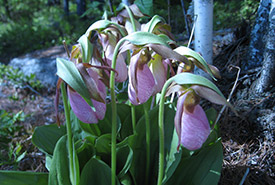
Pink lady's-slipper, Covey Hill (Photo by NCC)
Pink lady's-slipper
What does it look like?
The pink lady’s-slipper, or moccasin flower, is a perennial orchid. Its name comes from its pink, hollow, pouch-shaped flower, which looks like a slipper. Across its range, pink lady’s-slippers flower from April to July. The plant has an erect, leafless stem, measuring between 15 and 61 centimetres in height, and two oval-shaped leaves with parallel veins at its base.
Where is it found?
The pink lady’s-slipper can be found in the Northwest Territories, all provinces except BC, as well as the eastern United States. It is the provincial floral emblem of Prince Edward Island.
This species is found in dry forests (especially pine and other coniferous forests), moist woods, bogs, swamps, brushy barrens, heaths and roadsides. It prefers humus-rich, sandy, strongly acidic, aerated soil and grows in moderate shade and well-drained slopes.
How does it reproduce?
This species reproduces sexually through deceptive pollination, which means that it falsely advertises a reward (e.g. nectar) to attract potential insect pollinators, such as bumble bees. Asexual reproduction occurs through underground rhizomes (horizontal plant stems). The plant’s seeds require the right habitat and a specific type of soil fungus to germinate.
What is this species’ conservation status?
Fortunately, the pink lady’s-slipper has been assessed as least concern globally and is secure in Canada. It faces several threats, including exploitation for horticultural and medicinal purposes; habitat loss and disturbance from urbanization and real estate development; competition with invasive species, such as Japanese honeysuckle; climate change; and forest habitat alterations through fire suppression.
What is NCC doing to protect habitat for this species?
The pink lady’s-slipper has been documented on several NCC properties across the country. In Atlantic Canada, it has been found on properties in northeastern and southeastern New Brunswick, throughout Nova Scotia and PEI, and on the southwest coast of Newfoundland. This species has also been spotted on properties in the Whitemouth River Watershed of Manitoba and in Ontario’s Frontenac Arch and Saugeen Bruce Peninsula. In Quebec, it is found on properties in the Laurentians and Green Mountains.





